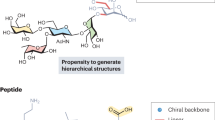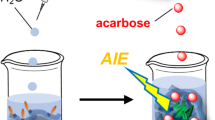Abstract
Specific molecular recognition is routine for biology, but has proved difficult to achieve in synthetic systems. Carbohydrate substrates are especially challenging, because of their diversity and similarity to water, the biological solvent. Here we report a synthetic receptor for glucose, which is biomimetic in both design and capabilities. The core structure is simple and symmetrical, yet provides a cavity which almost perfectly complements the all-equatorial β-pyranoside substrate. The receptor’s affinity for glucose, at Ka ~ 18,000 M−1, compares well with natural receptor systems. Selectivities also reach biological levels. Most other saccharides are bound approximately 100 times more weakly, while non-carbohydrate substrates are ignored. Glucose-binding molecules are required for initiatives in diabetes treatment, such as continuous glucose monitoring and glucose-responsive insulin. The performance and tunability of this system augur well for such applications.
This is a preview of subscription content, access via your institution
Access options
Access Nature and 54 other Nature Portfolio journals
Get Nature+, our best-value online-access subscription
$29.99 / 30 days
cancel any time
Subscribe to this journal
Receive 12 print issues and online access
$259.00 per year
only $21.58 per issue
Buy this article
- Purchase on Springer Link
- Instant access to full article PDF
Prices may be subject to local taxes which are calculated during checkout




Similar content being viewed by others
Data availability
The data supporting this study are provided in the Supplementary Information and are also available from the authors upon reasonable request.
References
Persch, E., Dumele, O. & Diederich, F. Molecular recognition in chemical and biological systems. Angew. Chem. Int. Ed. 54, 3290–3327 (2015).
Schrader, T. & Hamilton, A. D. Functional Synthetic Receptors (Wiley-VCH, Weinheim, 2005).
Smith, B. D. (ed.) Synthetic Receptors for Biomolecules: Design Principles and Applications (Royal Societyof Chemistry, Cambridge, 2015).
Kolesnichenko, I. V. & Anslyn, E. V. Practical applications of supramolecular chemistry. Chem. Soc. Rev. 46, 2385–2390 (2017).
Ma, X. & Zhao, Y. Biomedical applications of supramolecular systems based on host-guest interactions. Chem. Rev. 115, 7794–7839 (2015).
Oshovsky, G. V., Reinhoudt, D. N. & Verboom, W. Supramolecular chemistry in water. Angew. Chem. Int. Ed. 46, 2366–2393 (2007).
Kataev, E. A. & Muller, C. Recent advances in molecular recognition in water: artificial receptors and supramolecular catalysis. Tetrahedron 70, 137–167 (2014).
Davis, A. P. Supramolecular chemistry: sticking to sugars. Nature 464, 169–170 (2010).
Sun, X. L. & James, T. D. Glucose sensing in supramolecular chemistry. Chem. Rev. 115, 8001–8037 (2015).
Wu, Q., Wang, L., Yu, H. J., Wang, J. J. & Chen, Z. F. Organization of glucose-responsive systems and their properties. Chem. Rev. 111, 7855–7875 (2011).
Davis, A. P. & Wareham, R. S. Carbohydrate recognition through noncovalent interactions: a challenge for biomimetic and supramolecular chemistry. Angew. Chem. Int. Ed. 38, 2978–2996 (1999).
Draganov, A. et al. in Synthetic Receptors for Biomolecules: Design Principles and Applications (ed. Smith, B. D.) 177–203 (Royal Society of Chemistry, Cambridge, 2015).
Solis, D. et al. A guide into glycosciences: how chemistry, biochemistry and biology cooperate to crack the sugar code. Biochim. Biophys. Acta. Gen. Subj. 1850, 186–235 (2015).
Ambrosi, M., Cameron, N. R. & Davis, B. G. Lectins: tools for the molecular understanding of the glycocode. Org. Biomol. Chem. 3, 1593–1608 (2005).
Toone, E. J. Structure and energetics of protein-carbohydrate complexes. Curr. Opin. Struct. Biol. 4, 719–728 (1994).
Klein, E., Crump, M. P. & Davis, A. P. Carbohydrate recognition in water by a tricyclic polyamide receptor. Angew. Chem. Int. Ed. 44, 298–302 (2005).
Ferrand, Y., Crump, M. P. & Davis, A. P. A synthetic lectin analog for biomimetic disaccharide recognition. Science 318, 619–622 (2007).
Ke, C., Destecroix, H., Crump, M. P. & Davis, A. P. A simple and accessible synthetic lectin for glucose recognition and sensing. Nat. Chem. 4, 718–723 (2012).
Mooibroek, T. J. et al. A threading receptor for polysaccharides. Nat. Chem. 8, 69–74 (2016).
Rios, P. et al. Synthetic receptors for high-affinity recognition of O-GlcNAc derivatives. Angew. Chem. Int. Ed. 55, 3387–3392 (2016).
Rios, P. et al. Enantioselective carbohydrate recognition by synthetic lectins in water. Chem. Sci. 8, 4056–4061 (2017).
Sookcharoenpinyo, B., Klein, E., Ke, C. & Davis, A. P. Nucleoside recognition by oligophenyl-based synthetic lectins. Supramol. Chem. 25, 650–655 (2013).
Peck, E. M. et al. Rapid macrocycle threading by a fluorescent dye-polymer conjugate in water with nanomolar affinity. J. Am. Chem. Soc. 137, 8668–8671 (2015).
James, T. D., Phillips, M. D. & Shinkai, S. Boronic Acids in Saccharide Recognition (RSC, Cambridge, 2006).
Hennrich, G. & Anslyn, E. V. 1,3,5-2,4,6-Functionalized, facially segregated benzenes - exploitation of sterically predisposed systems in supramolecular chemistry. Chem. Eur. J. 8, 2218–2224 (2002).
Francesconi, O., Ienco, A., Moneti, G., Nativi, C. & Roelens, S. A self-assembled pyrrolic cage receptor specifically recognizes beta-glucopyranosides. Angew. Chem. Int. Ed. 45, 6693–6696 (2006).
Mazik, M. Recent developments in the molecular recognition of carbohydrates by artificial receptors. RSC Adv. 2, 2630–2642 (2012).
Asensio, J. L., Arda, A., Canada, F. J. & Jimenez-Barbero, J. Carbohydrate-aromatic interactions. Acc. Chem. Res. 46, 946–954 (2013).
Meyer, E. A., Castellano, R. K. & Diederich, F. Interactions with aromatic rings in chemical and biological recognition. Angew. Chem. Int. Ed. 42, 1210–1250 (2003).
Barwell, N. P., Crump, M. P. & Davis, A. P. A synthetic lectin for beta-glucosyl. Angew. Chem. Int. Ed. 48, 7673–7676 (2009).
Basu, A. et al. Continuous glucose monitor interference with commonly prescribed medications: a pilot study. J. Diabetes Sci. Technol. 11, 936–941 (2017).
Quiocho, F. A. Protein-carbohydrate interactions: basic molecular features. Pure Appl. Chem. 61, 1293–1306 (1989).
Zhao, F. Q. & Keating, A. F. Functional properties and genomics of glucose transporters. Curr. Genomics 8, 113–128 (2007).
Shoham, J., Inbar, M. & Sachs, L. Differential toxicity on normal transformed cells in-vitro and inhibition of tumour development in-vivo by Concanavalin-A. Nature 227, 1244–1246 (1970).
Acknowledgements
We thank the Bristol Chemical Synthesis Doctoral Training Centre for a studentship to R.A.T., funded jointly by Ziylo and the Engineering and Physical Sciences Research Council (EP/G036764/1).
Author information
Authors and Affiliations
Contributions
R.A.T. designed and carried out the synthetic route to receptor 2. M.G.O. and J.V.M. assisted in optimisation of the synthesis of compound 7. R.A.T. performed and analysed the binding studies, with assistance from T.S.C. and L.C. in some cases. R.A.T. and L.C. prepared the biological media. R.A.T. and M.P.C. were responsible for the structural NMR work, and H.L. performed the cytotoxicity studies. A.P.D. designed the receptor and directed the study. The paper was written by A.P.D. with input from the other authors.
Corresponding author
Ethics declarations
Competing interests
While this paper was under consideration, Ziylo Ltd was purchased by Novo Nordisk with a view to the development of glucose-responsive insulin. A new company Carbometrics was created to collaborate with Ziylo and explore other applications. A.P.D. was a director and shareholder of Ziylo, and is now a director and shareholder of Carbometrics. T.S.C., L.C., J.V.M. and M.G.O. were employees of Ziylo, J.V.M. and M.G.O. are now employees of Carbometrics.
Additional information
Publisher’s note: Springer Nature remains neutral with regard to jurisdictional claims in published maps and institutional affiliations.
Supplementary information
Supplementary Information
Synthesis and characterization of receptor 2; synthetic methods, NMR spectra, stability and toxicity. Details of binding studies; methods and media, summary of binding results, binding data and analyses. Details of modelling studies
Rights and permissions
About this article
Cite this article
Tromans, R.A., Carter, T.S., Chabanne, L. et al. A biomimetic receptor for glucose. Nature Chem 11, 52–56 (2019). https://doi.org/10.1038/s41557-018-0155-z
Received:
Accepted:
Published:
Issue Date:
DOI: https://doi.org/10.1038/s41557-018-0155-z
This article is cited by
-
Complexation-driven assembly of imine-linked helical receptors showing adaptive folding and temperature-dependent guest selection
Nature Communications (2024)
-
A charge-neutral organic cage selectively binds strongly hydrated sulfate anions in water
Nature Chemistry (2024)
-
Free-standing homochiral 2D monolayers by exfoliation of molecular crystals
Nature (2022)
-
Switchable bifunctional molecular recognition in water using a pH-responsive Endo-functionalized cavity
Nature Communications (2022)
-
Cucurbit[n]urils (n = 7, 8) can strongly bind neutral hydrophilic molecules in water
Science China Chemistry (2022)



